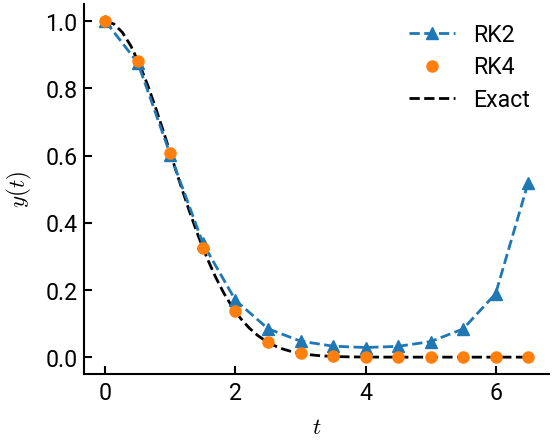Example 11-8: Higher-order Runge-Kutta#
Now that we have a second-order accurate algorithm, why stop there? We can use the same framework to build successively higher-order approximations. These solutions fall into a family of algorithms known as Runge-Kutta methods, which are very popular for solving ODEs. Understand why they work as well as their implementation is a key aspects of this course.
Summary of commands#
No new commands are demonstrated in this exercise, but we will expand on Example 11-7 to build fourth-order Runge-Kutta methods.
Runge-Kutta methods#
The hierarchy of Runge-Kutta methods come with tradeoffs, and the fourth-order Runge-Kutta method (RK4) provides a good balance between computational cost and accuracy. It is often parameterized by the following:
Consider the following ODE:
which has an exact solution of \(y = e^{-t^2/2}\). We will use RK2 (Heun’s method) and RK4 to solve the ODE using a step size of \(h = 0.5\).
# import libraries
import numpy as np
import matplotlib.pyplot as plt
def my_func(t, y):
return -t * y
def RK2Heun(f, t0, tf, y0, h):
y = [y0]
t = np.arange(t0, tf+h, h)
for n in range(len(t) - 1):
k1 = f(t[n], y[n])
k2 = f(t[n] + h, y[n] + h * k1)
y.append(y[n] + 0.5 * h * (k1 + k2))
return t, np.array(y)
def RK4(f, t0, tf, y0, h):
y = [y0]
t = np.arange(t0, tf+h, h)
for n in range(len(t) - 1):
k1 = f(t[n], y[n])
k2 = f(t[n] + 0.5 * h, y[n] + 0.5 * h * k1)
k3 = f(t[n] + 0.5 * h, y[n] + 0.5 * h * k2)
k4 = f(t[n] + h, y[n] + h * k3)
y.append(y[n] + 1/6 * h * (k1 + 2 * k2 + 2 * k3 + k4))
return t, np.array(y)
# constants
t0 = 0
tf = 6.5
y0 = 1
h = 0.5
t2, y_rk2 = RK2Heun(my_func, t0, tf, y0, h)
t4, y_rk4 = RK4(my_func, t0, tf, y0, h)
t = np.linspace(0, 6.5, 51)
# plot results
fig, ax = plt.subplots()
ax.plot(t2, y_rk2, '^--', lw=2, label='RK2')
ax.plot(t4, y_rk4, 'o', lw=2, label='RK4')
ax.plot(t, np.exp(-t ** 2 / 2), 'k--', lw=2, label='Exact', zorder=-5)
ax.set(xlabel='$t$', ylabel='$y(t)$')
ax.legend()
plt.show()

From which it is evident that RK2 begins to exhibit instability at \(h = 0.5\) but RK4 remains stable.

